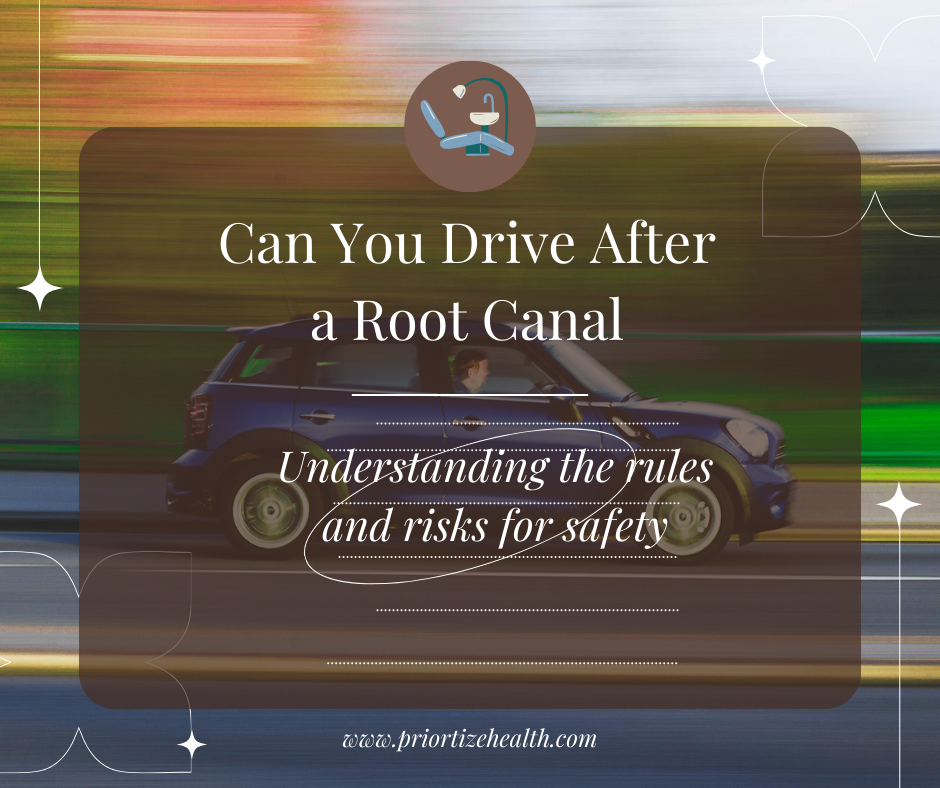
Can You Drive After a Root Canal: Understanding the rules and risks for safety
“Can you drive after a root canal?” It’s a question many individuals find themselves asking after undergoing this dental procedure. The root canal itself may not impact your driving abilities directly. But there are essential rules and risks to consider when getting back behind the wheel. In this article, we’ll explore the factors that determine whether it’s safe to drive after a root canal. Let’s know what precautions you should take to ensure your safety and that of others on the road.
What Is a Root Canal?
A root canal is a dental procedure that involves a process to save an infected or damaged tooth. It is also known as endodontic therapy. The procedure involves removing the pulp. It is the soft tissue inside the tooth, and the nerve, cleaning and disinfecting the inside of the tooth. The next step is to seal it to prevent further infection.
Understanding the Procedure
Here’s a step-by-step explanation of what happens during a root canal:
- Diagnosis: The dentist will first take X-rays to assess the extent of the infection or damage. They will determine if a root canal is necessary. There are some common reasons for needing a root canal. It includes deep decay, a cracked or fractured tooth, or a severe infection.
- Anesthesia: Before the procedure begins, the dentist will administer a local anesthetic. They will numb the affected tooth and the surrounding area. This ensures that you don’t feel any pain during the procedure.
- Isolation: The doctor places a rubber dam or a dental sheet around the tooth. This helps to keep it dry and free from saliva during the procedure.
- Access Opening: The dentist drills a small access hole in the top of the tooth. It helps to reach the pulp chamber and root canals.
- Pulp Removal: The doctor removes the infected or damaged pulp, along with the nerve from the tooth. They use specialized tools to perform the procedure. This eliminates the source of pain and infection.
- Cleaning and Shaping: The doctor cleans and disinfect the interior of the tooth. They then shape it using tiny instruments. This helps to remove any remaining bacteria and debris.
- Filling: In the next step the dentist fills the empty space with a biocompatible material. It is popular by the term gutta-percha to seal the canals.
- Restoration: In most cases, the doctor place a temporary filling in the access opening. Later, a permanent restoration, such as a crown, is often recommended. It helps to protect the tooth and restore its function and appearance.
An endodontist performs the root canal procedure. They are a dentist with specialized training in treating the inside of teeth. Once the procedure is complete, the tooth should be pain-free. It can continue to function in a normal manner in your mouth.
Root canals are an essential dental treatment for saving teeth. You might otherwise need to extract it due to severe infection or damage. They can relieve pain, preserve your natural smile, and prevent further dental complications.
When is it Necessary?
A root canal is necessary when the pulp of a tooth becomes infected, inflamed, or damaged. The pulp is the innermost part of a tooth. It contains nerves, blood vessels, and connective tissue. When the pulp is compromised, it can cause significant pain. If this is left untreated, it can lead to severe dental and health problems.
Here are some common situations that makes root canal necessary:
- Severe Tooth Decay: Deep cavities or dental caries can reach the pulp of the tooth. If the infection reaches this level, we might have to get a root canal done to remove the infected pulp and save the tooth.
- Cracked or Fractured Tooth: A crack or fracture in a tooth can allow bacteria to penetrate the pulp. This causes an infection or inflammation. A root canal is often necessary to address this issue.
- Abscess or Dental Infection: An infection can develop within the pulp or the root of a tooth. It can lead to an abscess, a painful collection of pus. This condition requires immediate treatment, often involving a root canal.
- Repeated Dental Procedures: Some teeth might need many dental procedures, such as fillings or crowns. Over time, the cumulative stress on a tooth can damage the pulp, making a root canal necessary.
- Trauma or Injury: A blow to the mouth or face can damage the pulp of a tooth. Even if there are no visible signs of injury, it may still affect the pulp, leading to the need for a root canal.
- Pain and Discomfort: Unexplained or severe tooth pain, can be a sign of pulp inflammation or infection. It may be especially when eating or applying pressure. So, in such cases, a root canal may be required to reduce the pain.
It’s important to note that not all cases of tooth pain or dental problems need a root canal. We can resolve some issues with other dental treatments, like fillings or crowns. It’s crucial to consult with a dentist or endodontist. They will guide to determine the appropriate course of action based on the specific condition of your tooth.
Early diagnosis and timely treatment are key to preserving a tooth’s health. It can also help in avoiding the need for extraction. Dentists use X-rays, clinical exams, and other diagnostic tools to assess the condition of the pulp. It helps them to determine whether a root canal is necessary.
Can You Drive Right After a Root Canal?
The short answer is, yes, you can generally drive yourself home after a root canal procedure. The local anesthetic used during the procedure may impair your sensation. But it shouldn’t affect your ability to operate a vehicle.
Yet, there are a few rules and risks to be aware of:
1. Local Anesthetic Effects:
The local anesthetic used for a root canal can affect your ability to feel and control your mouth and face. While this should not impact your driving skills. But you should be cautious for a few hours after the procedure.
2. Pain and Discomfort:
After the root canal, you may experience some pain, discomfort, or swelling. This can make driving less pleasant. So, it’s advisable to wait until you feel more comfortable before getting behind the wheel.
3. Medications and Drowsiness:
Dentists may prescribe pain medications or antibiotics after a root canal. Some of these medications can cause drowsiness. If you’re taking such medications, it’s best to avoid driving until their effects have worn off.
4. Individual Variability:
All individuals respond in a different manner to dental procedures, medications, and pain. What may be manageable for one person might be more challenging for another. Listen to your body and prioritize your comfort and safety.
Tips for Safe Driving Post-Root Canal
If you plan to drive after a root canal, consider these safety tips:
- Wait until the local anesthetic’s effects have worn off.
- Take any prescribed medications as directed, but avoid driving if they cause drowsiness.
- Plan for a shorter drive or have someone available to drive you if you don’t feel up to it.
- Pay close attention to your comfort level and well-being.
Conclusion
“Can you drive after a root canal?” The answer is generally yes, but it comes with a few important considerations. Safety should always be your top priority. Listen to your body, follow your dentist’s post-procedure instructions. Exercise caution if you experience any discomfort, drowsiness, or impaired sensations. By doing so, you can ensure a safe and smooth transition from the dentist’s chair to the driver’s seat. This will help in promoting your well-being and the safety of others on the road.
FAQ’s:
Ans: After a root canal procedure, it’s essential to avoid certain actions. You should not chew on the treated tooth until it’s restored. It help to prevent any damage to the temporary filling or crown. Don’t skip follow-up appointments. They are crucial for monitoring healing and ensuring proper restoration. If you experience persistent pain or swelling, contact your dentist. Don’t delay the recommended permanent restoration, like a crown. It can compromise the tooth’s strength and function. Maintain good oral hygiene to prevent further dental issues.
Ans: The actual root canal procedure is not painful as the procedure starts after local anesthesia. It numbs the affected tooth and surrounding area. Patients may feel some pressure during the procedure, but not sharp pain. But, it’s common for individuals to experience discomfort or mild pain after the procedure. We can manage it with over-the-counter pain relievers. The pain is usually a temporary response to the healing process. It should subside over a few days. There may be some post-procedure discomfort, but the root canal itself is not a painful experience due to effective anesthesia.
Ans: In most cases, you do not need to take time off work after a root canal. The procedure itself is minimally invasive and performed under local anesthesia. It allows you to return to work immediately afterward. But you may experience some post-procedure discomfort or pain. So, it’s advisable to gauge your comfort level and consider taking the rest of the day off or scheduling your root canal on a day off if possible. It’s essential to prioritize your well-being and choose what’s most comfortable for you.
You may also read the article: Effective Home Remedies for Tooth Sensitivity






4 Comments
I’m often to blogging and i really appreciate your content. The article has actually peaks my interest. I’m going to bookmark your web site and maintain checking for brand spanking new information.
I’m often to blogging and i really appreciate your content. The article has actually peaks my interest. I’m going to bookmark your web site and maintain checking for brand spanking new information.
My brother recommended I might like this web site He was totally right This post actually made my day You cannt imagine just how much time I had spent for this information Thanks
My brother recommended I might like this web site He was totally right This post actually made my day You cannt imagine just how much time I had spent for this information Thanks